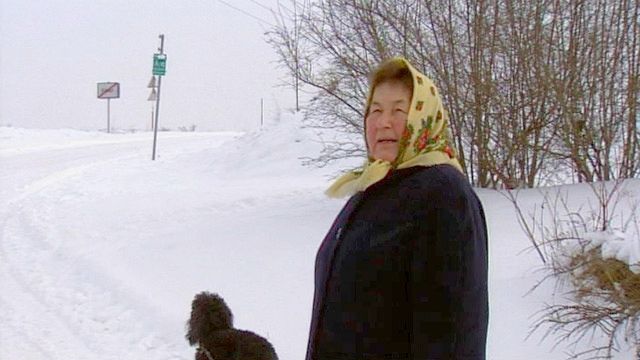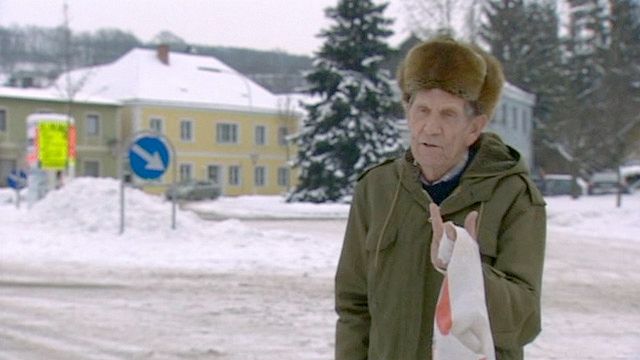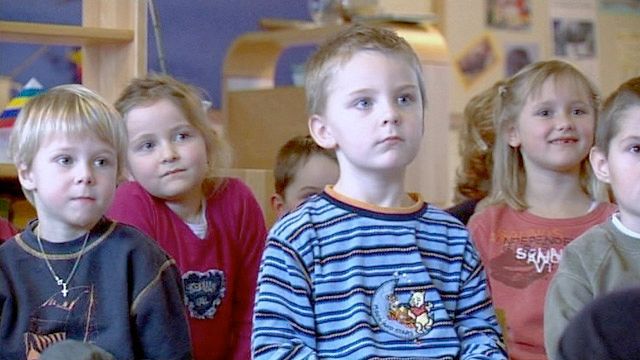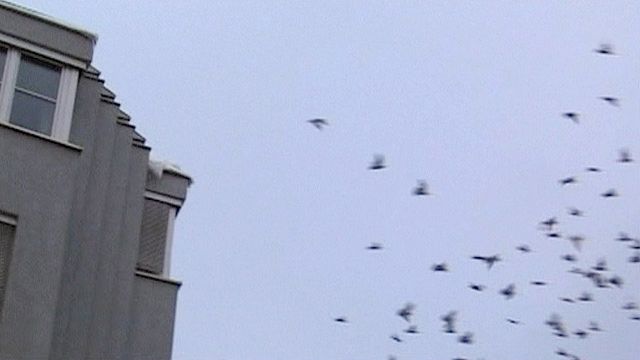Ulrike Schweiger
:
Die Ohren Wachsen
Back
Information
Die Ohren Wachsen
An Experiment with Harmony for Peace
Screenplay & directed by: Ulrike Schweiger
Camera: Nikolai Kanow
Sound: Bernhard Schmid
Editing: Charlotte Müllner
The background is familiar: on 8 May 1945 the officer in charge of the 65th US Infantry Division, Stanley E. Reinhart, and the commanding officer of the 7th Soviet Airborne Infantry Division, Major General D. A. Dritskyn, met one another for an official handshake that sealed the end of the Second World War on Austrian soil. Far less well-known to the public than the meeting between allies on 25 April 1945 in Torgau on the Elbe, and hardly known about even in Austria until an emigrant found out about it by chance, this event was to provide the occasion for a reorientation within the community. Erlauf established itself as a Peace Congregation, set-up a community museum and planned to organise art projects in close collaboration with the state government of Lower Austria. The first thoughts were of erecting a monument to peace that was envisaged for completion in the jubilee commemorative year of 1995 and intended to consist of two contributions, one from an American and one from a Russian artist.
Adopting the original idea, a sculpture by Oleg Komov of a group of figures showing the two commanding officers was donated to the community along official channels by the Soviet Union. To make sketches and prepare his work, Komov had come to Erlauf, where his presence had not passed without criticism or protest. That Jenny Holzer could be won over to make the counterpart was not least thanks to the great dedication of the local mayor, Franz Kuttner, who went to visit the artist and succeeded in persuading her to take on the commission for the second part of the monument. A more contrary pair of artworks is difficult to imagine than the two that constitute the Erlauf war memorial, situated on the main road and divided by a local thoroughfare. In contrast to the traditional group sculpture by Oleg Komov, Jenny Holzer’s contribution consists of a pole, a flag spotlight and a number of her typical text pieces which allude very literally to experiences of shock and horror and have a strongly pacifist orientation. Jenny Holzer came to Erlauf for the inauguration in 1995 (Oleg Komov had died by then) where, along with all the other visitors to the occasion with a critical attitude, she found out the hard way that 8 May 1995 was a date shared with a gathering of war veterans.
The two-part project Erlauf Remembers followed in 2000 and 2002, with Hedwig Saxenhuber as curator. The project was preceded by the general election in 1999 and the formation of a 'black and blue' coalition government.* With the rise of the Freedom Party to the second strongest political party in the country, subjects like the Nazi regime, coming to terms with the past and the way the past is dealt with became topical again to the extent that the party's right-wing populist approach made tackling such issues a crucial issue. Racism, xenophobia and marginalisation were subsequently also opposed vehemently by the opponents of this political shift. This was the situation addressed by Erlauf Remembers. The artwork by Ines Doujak, Nicole Knauer, Pia Lanzinger, Adrian Piper, Clemens Stecher and Milica Tomi? consisted mostly of temporary projects specially conceived for Erlauf. Pia Lanzinger, for instance, produced a kind of oral history, addressing questions to a number of Erlauf women who were married to a foreigner. Milica Tomi? addressed Komov's sculpture and supplemented the little girl positioned between the officers with local residents, not least to put her own position as a Serbian artist in context. In the second part in 2002, the participants were Alice Creischer, Sanja Ivekovi?, Werner Kaligofsky, Dorit Margreiter, Roman Ondák und Haroutioun Simonian. They addressed the ideational constructs involved in memory and how these are represented in contemporary art.
The year 2005 provided a round jubilee that, in the light of the ten years of activity in the community, we recently decided to celebrate with an artistic contribution. Erlauf continues to see itself as a place where peace is preserved, and wanted to make a significant statement to that effect for that year. After much debate it was decided to lend prominence to music. With the well-known composer and musician Konrad Rennert, we found a musician who was as skilful as he was enthusiastic. His proposal was to hold a concert on the day being commemorated in which everybody in Erlauf participated. The participatory aspect was of utmost importance in the undertaking, and an exciting process of development began in situ. Although he was aware that in the course of this development process things would continually be open to negative criticism or rejection – just as the previous artworks had been over previous years.
It is no secret that music plays a major role in the communities of Lower Austria, and Erlauf is no exception. Although the community only has 1200 inhabitants there is a lively cluster of clubs and hobby societies. The choir in traditional costume, the church and youth choirs as well as a local rock band subsequently became Rennert's main contact people. He described his aim as to achieve "a symbiosis of many different styles and directions, listening to one another and understanding, as well as a general tone of acceptance for the most varied of musical worlds." He called his concert, which actually took place as scheduled on 6 May 2005, "an experiment with harmony for peace" and gave it the title AMF – Allied Musical Forces, Erlauf. A Concert for Peace. It was both the highpoint and the end of months of brainstorming, rehearsals and preparations – in collaboration with the musician Katharina Wurglits – where opposing approaches to music finally came together. This notwithstanding, Rennert was still able to unite traditional music with the experimental, and so break with habitual ways of hearing and seeing.
Konrad Rennert was accompanied by the filmmaker Ulrike Schweiger, who made a 60-minute documentary following the progress from the first rehearsal to the concert. The film, bearing the descriptive title Die Ohren Wachsen,'> begins in winter and ends with the final performance. As well as following the composer's work, an eye is kept on the whole community, with particular individuals or places being spotlighted frequently in order to incorporate everyday life in Erlauf in the film. Schweiger sensitively and subtly marks her material with moments like one with a woman walking a dog who says at the start, that there might not be anything to see of any particular interest in Erlauf but there's still plenty going on. There is also the elderly gentleman who lives next to the station; we follow him throughout the course of the project and the changing seasons. Ulrike Schweiger, who became well-known for her full-length film Twinny, largely shot on location in the Waldviertel, succeeds in showing Rennert's work in a context of the location. She arouses the viewer's curiosity for the special aspects of this project, shows the location, its position on a main road, its situation with the commemorative sculpture etc., and lets this quite controversial situation flow into the finished film.
Konrad Rennert encounters the conditions in Erlauf with much joy and a great deal of perseverance. The distances involved, as is shown in the film, even had to be overcome in physical terms. In the film his arrival and departure are covered, too, although he is also shown in the train or writing in the coffee shop and working on the score, which becomes increasingly complex. The view of him taken by residents of Erlauf varies from the enthusiasm of little children to the scepticism of the aged. Although the film also shows that the enterprise was worthwhile and that Rennert established an experimental workshop that actually succeeded in providing hobby musicians with new perspectives. In this sense, after the performance, a young man emphasises that the experiment had been a success and that although he might not have liked everything, it had definitely been worth getting involved in the whole thing.
Alongside its declared intention of questioning common approaches to music and listening habits, the roughly one hour long musical collage had such an enormous communicative potential that the question 'Is it art?' coursing over the preceding years changed to 'Is it still music?' and addressed the entire community. In June 2005 the film was finally premiered and the event was covered in a final résumé before Erlauf allowed its jubilee year to come to an end, hopefully to be followed by new activities in the years to come.
(Susanne Neuburger)
The project is documented in the art archive of the museum ERLAUF ERINNERT .
* A coalition government between the conservative ÖVP and the right-wing populist FPÖ parties
'> Lit. 'the ears are growing', used metaphorically in German when somebody's curiosity is aroused.




